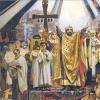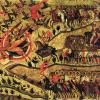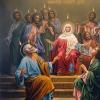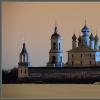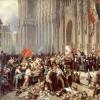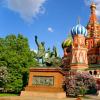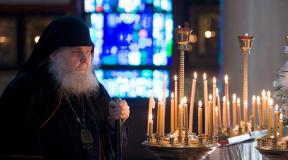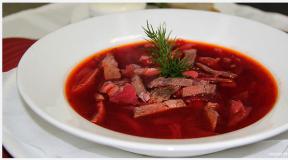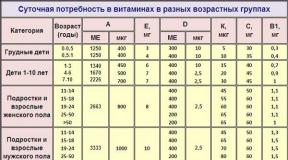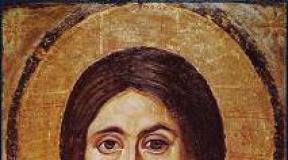Church on the moat. St. Basil's Cathedral - history and mysteries. Intercession Cathedral on Red Square. Architecture
- The Orthodox Cathedral of Saint Basil the Blessed (XVI century) is a symbol of Russian church architecture that time.
- In Soviet times, there was a museum here, services resumed in 1991. Now held every week.
- Architect, who built St. Basil's Cathedral, was called Barma Postnik.
- The magnificently decorated church was a thanksgiving to the Almighty for an outstanding military success - capture of Kazan.
- The cathedral is made up of nine separate churches, which are located on the same foundation and are connected by two galleries.
- The relics of St. Basil the Blessed, the holy fool who lived in Moscow in the 16th century, are buried in the temple.
The narrow galleries between the churches also have decoration: in the 17th century. they were painted with floral ornaments, and a little later - with narrative frescoes. Particular attention should be paid to the basement, which used to be a treasury. Its space is covered with complex box vaults. In addition, a collection of icons is exhibited in the basement, as well as silver utensils, samples of weapons and a beautiful cover on St. Basil's shrine, embroidered in the 16th century.
St. Basil the Blessed and shrines of the cathedral
Saint Basil the Blessed, whose relics are buried in the Cathedral, lived in Moscow in the 16th century. and was a holy fool - a religious ascetic who rejected worldly blessings. His life says that he walked around without clothes all year round, slept on the street and observed a strict fast. According to legend, he performed many miracles and possessed the gift of providence: Ivan the Terrible himself was afraid of his speeches. The saint was greatly revered, and his memory has survived to this day. The church also houses the tomb of Blessed John of Moscow.
The address: Russia, Moscow, Red Square
Start of construction: 1555
Completion of construction: 1561
Number of domes: 11
Height: 65 m
Coordinates: 55°45"09.4"N 37°37"23.5"E
Object of cultural heritage of the Russian Federation
Short story
July 12, 2011 celebrated its 450th anniversary of the most famous Orthodox church in Russia - Pokrovsky Cathedral, or St. Basil's Cathedral.
Located on Red Square next to the Kremlin, it has become a symbol of Moscow and the whole country. St. Basil's Cathedral is a whole city in the city: 10 churches with colorful domes were built on a single foundation. He was built in 1555 - 1561 by order of Ivan the Terrible to commemorate the victory over the Kazan Khanate- the age-old enemy of Russia.
View of the Cathedral from the Moscow Kremlin
An old Moscow legend says that during the decisive assault on Kazan, Ivan the Terrible went to the camp church, which was located in a tent, and prayed earnestly. But as soon as the priest had time to utter the words: “And there will be one flock and one shepherd,” the earth trembled from the strongest explosion, and part of the enemy fortifications flew into the air, opening the way for the Russian troops.
For the first time in the history of Russia, it included not a principality, but a whole state - the Kazan Khanate. The capture of Kazan had not only political significance (now the Russians controlled the Volga-Baltic trade route), but also religious - it was a campaign against the infidels. In Moscow, the townspeople greeted Ivan the Terrible with loud exclamations: "Many years to the pious tsar, the conqueror of the barbarians, the deliverer of the Orthodox people!"

Monument to Minin and Pozharsky against the backdrop of St. Basil's Cathedral
Basil's Cathedral - a masterpiece of unknown architects
Initially, a wooden church of the Holy Trinity stood on the site of the future temple, but in 1555 they began to build a stone cathedral, which still exists. Who was the chief architect remains a mystery. According to one version, the tsar invited the Pskov master Postnik Yakovlev, nicknamed Barma, according to another, the names Postnik and Barma belong to two different architects.
According to the third version, St. Basil's Cathedral is a project of an Italian architect. There is a legend that the king ordered the eyes of the creator of the cathedral to be gouged out so that he could no longer repeat his masterpiece. But if we consider the author of the Cathedral of Postnik, then this legend does not find documentary evidence. Postnik could not be blinded, because for several years after the completion of construction he worked on the project of the Kazan Kremlin.

View of the Cathedral from the side of Vasilyevsky Spusk
St. Basil's Cathedral - an outlandish constellation of tents and domes
St. Basil's Cathedral is crowned with 10 domes. 8 churches, located symmetrically around the main temple in the form of an eight-pointed star, symbolize church holidays that fall on the days of decisive battles for Kazan. On their tops there are 8 onion domes. The central church of the Intercession of the Virgin is completed with a tent with a small dome, and the tenth dome is built over the bell tower.
All 9 churches are united by a single base and an internal bypass gallery, painted with bizarre floral ornaments. None of the domes repeats the other. St. Basil's Cathedral was not always so colorful. The white stone and brick used in the construction of the church gave it austerity and restraint.

View of the Cathedral from Red Square
In the 17th century, the domes of the cathedral were decorated with ceramic tiles, asymmetrical extensions were added, tents were erected over the porches, and the walls were covered with intricate paintings. In 1931, a bronze Monument to Minin and Pozharsky, which had previously stood on Red Square, was erected in front of the cathedral.
St. Basil's Cathedral - a temple to the glory of the miracle worker
The main church of the temple was consecrated in honor of the Feast of the Intercession of the Most Holy Theotokos. However, the Intercession Church is called the Cathedral of St. Basil the Blessed and is associated not with Ivan the Terrible and the Kazan campaigns, but with the name of the Moscow holy fool - the man of God. Vasily lived on the streets of Moscow and even in severe frost went half-naked, wore chains on his body - iron chains with crosses. Ivan the Terrible himself treated him with reverence.

Kupala Cathedral
When Vasily fell seriously ill, the tsar visited him with his wife, Tsarina Anastasia. A number of miracles are attributed to the saint. While in Moscow, he put out the fire in Novgorod with three cups of wine. Basil denounced lies, and under external piety he could guess the actions of the devil. So, in front of the astonished pilgrims, he threw a stone at the image of the Mother of God, which was revered as miraculous. When the crowd began to beat Vasily, he shouted: “And you will scratch the primer!”. After removing the paint layer, people saw that a devil was drawn under the image of the Mother of God. Vasily died in 1552, and in 1588 a church was built over the burial place of the miracle worker's relics. This extension gave the common name to the Church of the Intercession - St. Basil's Cathedral.

Cathedral baths
Tradition claims that until 1595 the royal treasury was kept in the vaults of the temple. Today, the cathedral is jointly run by the Historical Museum of Moscow and the Russian Orthodox Church. On Sundays, services are held there.
They freeze in admiration when they see St. Basil's Cathedral, unsurpassed in its beauty, next to the Kremlin. This monument of Russian history and culture with its multi-colored painted domes has long become an integral part of the capital of Russia and its symbol. The official name of this attraction is the Cathedral of the Intercession of the Most Holy Theotokos on the Moat. Until the 17th century, the cathedral was called the Trinity Cathedral, since the originally built wooden church was dedicated to the Holy Trinity. Currently, the cathedral is included in the list of world cultural heritage and is under the protection of UNESCO.
The history of the construction of St. Basil's Cathedral.
The order to build the Intercession Cathedral was given by Ivan the Terrible in honor of the victory over the Kazan Khanate and the storming of the impregnable Kazan fortress. This event took place on the feast of the Intercession of the Most Holy Theotokos, in honor of which the temple was named. Construction began in 1555 and was completed six years later. There is no reliable information about the architects who built the cathedral. Most researchers are inclined to believe that this is the work of the Pskov master Postnik Yakovlev, who had the nickname Barma.

After the addition to the existing churches in 1588 of the Church of St. Basil the Blessed, the cathedral acquired its name. As conceived by the author, the ensemble of temples was a symbol of Heavenly Jerusalem. Instead of burnt church coverings, at the end of the 16th century, figured domes, familiar to our eyes, appeared.

In the 80s of the 17th century, porches decorated with tents were erected above the stairs leading to the temple, and the open gallery surrounding the cathedral acquired vaults. In painting the surface of the gallery, the masters used herbal motifs, and during the restoration work of the first half of the 19th century, a cast-iron fence was installed around the cathedral.



From the first days of Soviet power, St. Basil's Cathedral in Moscow has been under the protection of the state, although until 1923 it was in disrepair. After the creation of a historical and architectural museum in it, major construction work was done and the collection of funds was carried out. May 21, 1923 the first visitors stepped over its threshold. Since 1928 it has been a branch of the State Historical Museum. At the end of 1929, the bells were removed from the temple and it was forbidden to hold services. During the Great Patriotic War, the museum was closed, but after its completion and regular restoration measures, the museum reopened its doors to visitors. The beginning of the 90s of the XX century was marked by the resumption of church services in the temple. Since that time, the cathedral has been shared by the museum and the Russian Orthodox Church.

The height of St. Basil's Cathedral is 65 meters. But, despite this modest figure, the beauty of the cathedral leaves no one indifferent. Due to the fact that its ensemble includes nine churches built on a common foundation, it is included in the list of the largest cathedrals in the world in terms of volume. The uniqueness of the temple lies in the fact that it does not have a clearly defined main entrance. When entering a temple for the first time, one can get confused about its layout. But, if you look at him from a bird's eye view, or at his drawing (top view), placed on the wall of one of the churches, everything becomes clear and understandable.

Churches of St. Basil's Cathedral.
In the center of the complex stands a pillar-shaped church, consecrated in honor of the Intercession of the Most Holy Theotokos. The central exits of the main temples surrounding it face the four cardinal directions. Smaller churches were erected between them, completing the composition. When looking at the entire ensemble from above, one can clearly see two squares turned to each other at an angle and making up a regular eight-pointed star, symbolizing the resurrection of Jesus Christ. The very sides of the squares, in addition to the four ends of the life-giving cross, meant the firmness of faith. And the unification of churches around the Pillar Church symbolizes the unity of faith and God's protection, spread over Russia. The bell tower, built in 1670, is a little further away.

Secret in the temple.
Another feature of the unique ensemble is the absence of basements. It was erected on the basement - a complex of premises, the height of the walls of which exceeds six meters, and the thickness reaches more than three meters. Special openings are provided in its walls, which serve to create a constant microclimate in the premises, which does not depend on the season. In ancient times, the basement was used as a secret storage for church valuables and the royal treasury. The cache could only be accessed from the second floor of the central cathedral through a secret staircase located in the wall. Now there is a storage of icons that belong to the Church of the Intercession of the Most Holy Theotokos on the Moat. The oldest of them is the image of St. Basil the Blessed, dating from the end of the 16th century.

The whole ensemble is encircled by a covered bypass gallery, which has long become one with it. Like the inner bypass, it is painted with herbal and floral patterns dating back to the 17th century. Their floors are brick-lined, partly with herringbone masonry, and some areas with a special rosette pattern. Interestingly, the bricks preserved from the sixteenth century are more resistant to abrasion than those used in restoration work.

Basil's Cathedral inside.
The interior decoration of all the nine temples that make up the complex is not similar to one another and differs in the style of painting, colors and manner of its execution. Some of the walls are decorated with oil painting, and some have frescoes dating back to the sixteenth century. The main wealth of the cathedral is its unique iconostases, which contain more than four hundred priceless icons dating back to the period of the 16th-19th centuries and belonging to the brush of Moscow and Novgorod masters.


After the return of the temple to the bosom of the Orthodox Church, which took place on the feast of the Intercession, the museum began to renew the collection of bells. Today you can see nineteen exhibits representing masterpieces of foundry art. The "oldest" of them was cast five years before the capture of Kazan, and the youngest in 2016 turns twenty years old. With your own eyes you can see the armor and weapons with which the troops of Ivan the Terrible went to attack the Kazan Kremlin.


In addition to the unique icons inside St. Basil's Cathedral, you can get acquainted with the canvases of Russian masters of portrait and landscape painting of the nineteenth century. The pride of the museum exposition is a collection of old handwritten and early printed books. You can see all the priceless exhibits of the museum and wander around the Cathedral of the Intercession of the Blessed Virgin Mary as part of a group tour, or book an individual visit. It should be remembered that you can take photos and videos by making a separate payment through the museum's cash desk. Between the basement and the second floor of the temple there are shops where you can buy a souvenir as a keepsake.
Coordinates : 55°45′08.88″ N sh. 37°37′23″ E d. / 55.752467° N sh. 37.623056° E d.(G) (O) (I)55.752467 , 37.623056
Cathedral of the Intercession of the Most Holy Theotokos on the Moat, also called St. Basil's Cathedral- Orthodox churchlocated on the Red Square of Kitay-gorod in Moscow. Widely known monument of Russian architecture. Until the 17th century, it was usually called Trinity, since the original wooden church was dedicated to the Holy Trinity; was also known as "Jerusalem", which is associated both with the dedication of one of the chapels, and with the procession to it from the Assumption Cathedral on Palm Sunday with the "procession on a donkey" of the Patriarch.
Status

St. Basil's Cathedral
Currently, the Pokrovsky Cathedral is a branch of the State Historical Museum. Included in the List of UNESCO World Heritage Sites in Russia.
Pokrovsky Cathedral is one of the most famous sights of Russia. For many, he is a symbol of Moscow, the Russian Federation. Since 1931, a bronze Monument to Minin and Pozharsky has been placed in front of the cathedral (installed on Red Square in 1818).
History
Versions about creation
The Cathedral of the Intercession was built in 1950 by order of Ivan the Terrible in memory of the capture of Kazan and the victory over the Kazan Khanate. There are several versions about the founders of the cathedral. According to one version, the famous Pskov master Postnik Yakovlev, nicknamed Barma, was the architect. According to another, widely known version, Barma and Postnik are two different architects, both involved in the construction; this version is now obsolete. According to the third version, the cathedral was built by an unknown Western European master (presumably an Italian, as before - a significant part of the structures of the Moscow Kremlin), hence such a unique style, combining the traditions of both Russian architecture and European architecture of the Renaissance, but this version is still never found any clear documentary evidence.
According to legend, the architect (architects) of the cathedral were blinded by order of Ivan the Terrible so that they could no longer build a similar temple. However, if the author of the cathedral is Postnik, then he could not be blinded, since for several years after the construction of the cathedral he participated in the creation of the Kazan Kremlin.
Cathedral at the end of the XVI - XIX centuries.
- in honor of St. Nicholas the Wonderworker (in honor of his Velikoretskaya icon from Vyatka),
- in honor of martyr Adrian and Natalia (originally - in honor of St. Cyprian and Justina - October 2),
- St. John the Merciful (until XVIII - in honor of St. Paul, Alexander and John of Constantinople - November 6),
- Alexander Svirsky (April 17 and August 30),
- Varlaam Khutynsky (November 6 and 1st Friday of Petrov Lent),
- Gregory of Armenia (September 30).
All these eight churches (four axial, four smaller ones between them) are crowned with onion domes and are grouped around the ninth pillar-shaped church towering above them in honor of the Intercession of the Mother of God, completed with a tent with a small dome. All nine churches are united by a common foundation, bypass (originally open) gallery and internal vaulted passages.
First floor
Basement

"Our Lady of the Sign" in the basement
There are no basements in the Intercession Cathedral. Churches and galleries stand on a single base - a basement, consisting of several rooms. Strong brick walls of the basement (up to 3 m thick) are covered with vaults. The height of the premises is about 6.5 m.
The construction of the northern basement is unique for the 16th century. Its long box vault has no supporting pillars. The walls are cut with narrow holes - products. Together with a "breathing" building material - brick - they provide a special microclimate of the room at any time of the year.
Previously, the basement premises were inaccessible to parishioners. Deep niches-hiding places in it were used as storage facilities. They were closed with doors, from which the hinges are now preserved.
Until 1595, the royal treasury was hidden in the basement. Wealthy citizens also brought their property here.
They got into the basement from the upper central church of the Intercession of the Mother of God along the intra-walled white stone staircase. Only the initiates knew about it. Later, this narrow passage was laid. However, during the restoration process of the 1930s. a secret staircase was discovered.
In the basement there are icons of the Intercession Cathedral. The oldest of them is the icon of St. Basil the Blessed at the end of the 16th century, written especially for the Pokrovsky Cathedral.
The icon "Our Lady of the Sign" is a replica of the facade icon located on the eastern wall of the cathedral. Written in the 1780s. In the XVIII-XIX centuries. the icon was above the entrance to the chapel of St. Basil the Blessed.
Church of St. Basil the Blessed

Canopy over the grave of St. Basil the Blessed
The lower church was added to the cathedral in 1588 over the burial place of St. Basil the Blessed. A stylized inscription on the wall tells of the construction of this church after the canonization of the saint at the behest of Tsar Fyodor Ioannovich.
The temple is cubic in shape, covered with a groin vault and crowned with a small light drum with a cupola. The covering of the church is made in the same style with the domes of the upper churches of the cathedral.
The oil painting of the church was made for the 350th anniversary of the beginning of the construction of the cathedral (1905). The Almighty Savior is depicted in the dome, the forefathers are depicted in the drum, the Deesis (the Savior Not Made by Hands, the Mother of God, John the Baptist) is depicted in the crosshairs of the arch, the Evangelists are in the sails of the arch.
On the western wall there is a temple image "Protection of the Most Holy Theotokos". In the upper tier there are images of the patron saints of the reigning house: Theodore Stratilates, John the Baptist, St. Anastasia, the martyr Irina.
On the northern and southern walls are scenes from the life of St. Basil the Blessed: "The Miracle of Salvation at Sea" and "The Miracle of the Fur Coat". The lower tier of the walls is decorated with a traditional ancient Russian ornament in the form of towels.
The iconostasis was completed in 1895 according to the project of the architect A.M. Pavlinov. The icons were painted under the guidance of the famous Moscow icon painter and restorer Osip Chirikov, whose signature is preserved on the icon "The Savior on the Throne".
The iconostasis includes earlier icons: “Our Lady of Smolensk” of the 16th century. and the local image "St. Basil the Blessed against the backdrop of the Kremlin and Red Square" XVIII century.
Above the burial of St. Basil the Blessed, an arch decorated with a carved canopy was installed. This is one of the revered Moscow shrines.
On the southern wall of the church there is a rare large-sized icon painted on metal - “The Mother of God of Vladimir with selected saints of the Moscow circle “Today the most glorious city of Moscow flaunts brightly” (1904)
The floor is covered with cast-iron plates of Kasli casting.
St. Basil's Church was closed in 1929. Only at the end of the 20th century. its decoration was restored. On August 15, 1997, on the feast day of Saint Basil the Blessed, Sunday and holiday services were resumed in the church.
Second floor
Galleries and porches

Along the perimeter of the cathedral around all the churches there is an external bypass gallery. It was originally open. In the middle of the XIX century. the glazed gallery became part of the interior of the cathedral. Arched entrances lead from the outer gallery to the platforms between the churches and connect it with the internal passages.
The central church of the Intercession of the Mother of God is surrounded by an internal bypass gallery. Its vaults hide the upper parts of the churches. In the second half of the XVII century. the gallery was painted with floral ornaments. Later, narrative oil painting appeared in the cathedral, which was repeatedly updated. Currently, tempera painting has been uncovered in the gallery. Oil paintings of the 19th century have been preserved in the eastern section of the gallery. - images of saints in combination with floral ornaments.
Carved brick entrances leading to the central church organically complement the decor. The portal has been preserved in its original form, without late plastering, which allows you to see its decoration. The relief details are laid out from specially molded patterned bricks, and the shallow decor is carved on site.
Previously, daylight entered the gallery from windows located above the passages to the promenade. Today it is illuminated by mica lanterns of the 17th century, which were previously used during religious processions. The multi-headed tops of the remote lanterns resemble the exquisite silhouette of the cathedral.
The floor of the gallery is made of bricks "in the Christmas tree". Bricks from the 16th century have been preserved here. - darker and more resistant to abrasion than modern restoration bricks.

Gallery painting
The vault of the western section of the gallery is covered with a flat brick ceiling. It demonstrates a unique for the XVI century. engineering method of the flooring device: many small bricks are fixed with lime mortar in the form of caissons (squares), the edges of which are made of figured bricks.
In this section, the floor is lined with a special rosette pattern, and the original painting imitating brickwork has been recreated on the walls. The size of the drawn bricks corresponds to the real one.
Two galleries unite the aisles of the cathedral into a single ensemble. Narrow internal passages and wide platforms give the impression of a "city of churches". Having passed the labyrinth of the inner gallery, you can get to the platforms of the porches of the cathedral. Their arches are "flower carpets", the intricacies of which fascinate and attract the eyes of visitors.
On the upper platform of the right porch in front of the Church of the Entry of the Lord into Jerusalem, the bases of pillars or columns have been preserved - the remains of the decoration of the entrance. This is due to the special role of the church in the complex ideological program of the consecrations of the cathedral.
Church of Alexander Svirsky

Dome of Alexander Svirsky Church
The southeastern church was consecrated in the name of St. Alexander of Svir.
In 1552, on the day of memory of Alexander Svirsky, one of the most important battles of the Kazan campaign took place - the defeat of the cavalry of Tsarevich Yapanchi on the Arsk field.
This is one of four small churches 15 m high. Its base - a quadrangle - turns into a low octagon and ends with a cylindrical light drum and vault.
The original appearance of the interior of the church was restored during the restoration work of the 1920s and 1979-1980s: a brick floor with a herringbone pattern, profiled cornices, and stepped window sills. The walls of the church are covered with paintings imitating brickwork. The dome depicts a "brick" spiral - a symbol of eternity.
The iconostasis of the church has been reconstructed. Icons of the 16th - early 18th centuries are located close to each other between the wooden beams (tablas). The lower part of the iconostasis is covered with hanging shrouds skillfully embroidered by craftswomen. On velvet shrouds - the traditional image of the Calvary cross.
Church of Varlaam Khutynsky

Royal doors of the iconostasis of the Church of Varlaam Khutynsky
The southwestern church was consecrated in the name of the Monk Varlaam Khutynsky.
This is one of the four small churches of the cathedral with a height of 15.2 m. Its base has the shape of a quadrangle, elongated from north to south with the apse shifted to the south. The violation of symmetry in the construction of the temple is caused by the need to arrange a passage between the small church and the central one - the Intercession of the Mother of God.
Four turns into a low octagon. The cylindrical light drum is covered with a vault. The church illuminates the oldest chandelier in the cathedral of the 15th century. A century later, Russian craftsmen added a pommel in the shape of a double-headed eagle to the work of the Nuremberg masters.
The table iconostasis was reconstructed in the 1920s. and consists of icons of the XVI - XVIII centuries. The peculiarity of the architecture of the church - the irregular shape of the apse - determined the shift of the Royal Doors to the right.
Of particular interest is the separately hanging icon "The Vision of Sexton Tarasius". It was written in Novgorod at the end of the 16th century. The plot of the icon is based on the legend about the vision of the Khutynsky Monastery's sexton of disasters that threaten Novgorod: floods, fires, "pestilence".
The icon painter depicted the panorama of the city with topographical accuracy. The composition organically includes scenes of fishing, plowing and sowing, telling about the daily life of the ancient Novgorodians.
Church of the Entry of the Lord into Jerusalem

Royal Doors of the Church of the Entry of the Lord into Jerusalem
The Western Church is consecrated in honor of the feast of the Lord's Entry into Jerusalem.
One of the four large churches is an octagonal two-tiered pillar covered with a vault. The temple is distinguished by its large size and the solemn nature of the decoration.
During the restoration, fragments of the architectural decoration of the 16th century were discovered. Their original appearance has been preserved without the restoration of damaged parts. No ancient painting was found in the church. The whiteness of the walls emphasizes the architectural details, executed by architects with great creative imagination. Above the northern entrance there is a trace of a shell that hit the wall in October 1917.
The current iconostasis was transferred in 1770 from the dismantled Alexander Nevsky Cathedral in the Moscow Kremlin. It is richly decorated with openwork gilded pewter overlays, which give lightness to the four-tiered structure. In the middle of the XIX century. the iconostasis was supplemented with wooden carved details. The icons of the lower row tell about the Creation of the world.
The church presents one of the shrines of the Intercession Cathedral - the icon "St. Alexander Nevsky in his life» of the 17th century. The image, unique in terms of iconography, probably comes from the Alexander Nevsky Cathedral.
The right-believing prince is represented in the middle of the icon, and around him there are 33 hallmarks with plots from the life of the saint (miracles and real historical events: the Neva battle, the prince's trip to the khan's headquarters, the battle of Kulikovo).
Church of St. Gregory of Armenia
The northwestern church of the cathedral was consecrated in the name of St. Gregory, Enlightener of Greater Armenia (d. 335). He converted the king and the whole country to Christianity, was the bishop of Armenia. His memory is celebrated on September 30 (October 13, N.S.). In 1552, on this day, an important event of the campaign of Tsar Ivan the Terrible took place - the explosion of the Arskaya tower in Kazan.

One of the four small churches of the cathedral (15m high) is a quadrangle, turning into a low octagon. Its base is elongated from north to south with the apse shifted. The violation of symmetry is caused by the need to arrange a passage between this church and the central one - the Intercession of the Mother of God. The light drum is covered with a vault.
The architectural decoration of the 16th century has been restored in the church: ancient windows, semi-columns, cornices, a brick floor laid out “in a Christmas tree”. As in the 17th century, the walls are whitewashed, which emphasizes the severity and beauty of the architectural details.
The tyabla (tyabla - wooden beams with grooves between which icons were fastened) iconostasis was reconstructed in the 1920s. It consists of windows of the XVI-XVII centuries. The royal gates are shifted to the left - due to the violation of the symmetry of the internal space.
In the local row of the iconostasis is the image of St. John the Merciful, Patriarch of Alexandria. Its appearance is connected with the desire of the wealthy contributor Ivan Kislinsky to re-consecrate this chapel in honor of his heavenly patron (1788). In the 1920s The church was given back its original name.
The lower part of the iconostasis is covered with silk and velvet shrouds depicting Calvary crosses. The interior of the church is complemented by the so-called "skinny" candles - large painted wooden candlesticks of the old form. In their upper part there is a metal base, in which thin candles were placed.
In the display case there are items of priestly vestments of the 17th century: surplice and phelonion, embroidered with gold threads. The 19th-century kandilo, decorated with multi-colored enamel, gives a special elegance to the church.
Church of Cyprian and Justina

Dome of the Church of Cyprian and Justina
The northern church of the cathedral has an unusual dedication for Russian churches in the name of the Christian martyrs Cyprian and Justina, who lived in the 4th century. Their memory is celebrated on October 2 (N.S. 15). On this day in 1552, the troops of Tsar Ivan IV stormed Kazan.
This is one of the four large churches of the Intercession Cathedral. Its height is 20.9 m. The high octagonal pillar is completed with a light drum and a dome, in which Our Lady of the Burning Bush is depicted. In the 1780s oil painting appeared in the church. On the walls are scenes from the lives of the saints: in the lower tier - Adrian and Natalia, in the upper tier - Cyprian and Justina. They are complemented by multi-figure compositions on the theme of gospel parables and stories from the Old Testament.
The appearance in the painting of images of martyrs of the 4th century. Adrian and Natalia is associated with the renaming of the church in 1786. A wealthy contributor Natalya Mikhailovna Khrushcheva donated funds for repairs and asked to consecrate the church in honor of her heavenly patrons. At the same time, a gilded iconostasis in the style of classicism was also made. It is a magnificent example of skillful woodcarving. The bottom row of the iconostasis depicts scenes of the Creation of the World (day one and four).
In the 1920s, at the beginning of scientific museum activities in the cathedral, the church returned to its original name. Recently, it appeared before the visitors updated: in 2007, the wall paintings and the iconostasis were restored with the charitable support of the Russian Railways Joint-Stock Company.
Church of St. Nicholas Velikoretsky

Iconostasis of the Church of St. Nicholas Velikoretsky
The southern church was consecrated in the name of the Velikoretsky icon of St. Nicholas the Wonderworker. The icon of the saint was found in the city of Khlynov on the Velikaya River and subsequently received the name "Nikola Velikoretsky".
In 1555, by order of Tsar Ivan the Terrible, the miraculous icon was brought in procession along the rivers from Vyatka to Moscow. An event of great spiritual significance determined the dedication of one of the chapels of the Intercession Cathedral under construction.
One of the large churches of the cathedral is a two-tiered octagonal pillar with a light drum and vault. Its height is 28 m.
The ancient interior of the church was badly damaged during a fire in 1737. In the second half of the 18th - early 19th centuries. a single complex of decorative and fine arts was formed: a carved iconostasis with full ranks of icons and a monumental narrative painting of the walls and vault. The lower tier of the octagon contains the texts of the Nikon Chronicle about bringing the image to Moscow and illustrations for them.
In the upper tier, the Mother of God is depicted on the throne, surrounded by prophets, above - the apostles, in the vault - the image of the Almighty Savior.
The iconostasis is richly decorated with gilded stucco floral decorations. Icons in narrow profiled frames are painted in oil. In the local row there is an image of "St. Nicholas the Wonderworker in his life" of the 18th century. The lower tier is decorated with gesso engraving imitating brocade fabric.
The interior of the church is complemented by two remote double-sided icons depicting St. Nicholas. With them they made religious processions around the cathedral.
At the end of the XVIII century. The floor of the church was covered with white stone slabs. During the restoration work, a fragment of the original covering made of oak checkers was discovered. This is the only place in the cathedral with a preserved wooden floor.
In 2005-2006 The iconostasis and monumental painting of the church were restored with the assistance of the Moscow International Currency Exchange.
Church of the Holy Trinity
The eastern one is consecrated in the name of the Holy Trinity. It is believed that the Pokrovsky Cathedral was built on the site of the ancient Trinity Church, by whose name the entire church was often called.
One of the four large churches of the cathedral is a two-tiered octagonal pillar, ending with a light drum and a dome. Its height is 21 m. In the process of restoration in the 1920s. in this church, the ancient architectural and decorative decoration was most fully restored: semi-columns and pilasters framing the arches-entrances of the lower part of the octagon, a decorative belt of arches. In the vault of the dome, a spiral is laid out with small-sized bricks - a symbol of eternity. Stepped window sills in combination with the whitewashed surface of the walls and vault make the Trinity Church especially bright and elegant. Under the light drum, “voices” are mounted in the walls - clay vessels designed to amplify sound (resonators). The church illuminates the oldest Russian chandelier in the cathedral from the end of the 16th century.
On the basis of restoration studies, the form of the original, so-called “tabla” iconostasis (“tabla” - wooden beams with grooves between which the icons were fastened close to each other) was established. The peculiarity of the iconostasis is the unusual shape of the low royal doors and three-row icons that form three canonical ranks: prophetic, Deesis and festive.
"The Old Testament Trinity" in the local row of the iconostasis is one of the most ancient and revered icons of the cathedral of the second half of the 16th century.
Church of the Three Patriarchs
The northeastern church of the cathedral was consecrated in the name of the three Patriarchs of Constantinople: Alexander, John and Paul the New.
In 1552, on the day of memory of the Patriarchs, an important event of the Kazan campaign took place - the defeat by the troops of Tsar Ivan the Terrible of the cavalry of the Tatar prince Yapanchi, who was marching from the Crimea to help the Kazan Khanate.
This is one of the four small churches of the cathedral with a height of 14.9 m. The walls of the quadrangle pass into a low octagon with a cylindrical light drum. The church is interesting for its original ceiling system with a wide dome, in which the composition "The Savior Not Made by Hands" is located.
The wall oil painting was made in the middle of the 19th century. and reflects in its plots the then change in the name of the church. In connection with the transfer of the throne of the cathedral church of Gregory of Armenia, it was re-consecrated in memory of the Enlightener of Great Armenia.
The first tier of the painting is dedicated to the life of St. Gregory of Armenia, in the second tier - the history of the image of the Savior Not Made by Hands, bringing it to King Avgar in the Asia Minor city of Edessa, as well as scenes from the life of the Patriarchs of Constantinople.
The five-tiered iconostasis combines baroque elements with classical ones. This is the only altar barrier in the cathedral from the middle of the 19th century. It was made especially for this church.
In the 1920s, at the beginning of scientific museum activities, the church returned to its original name. Continuing the traditions of Russian patrons, the leadership of the Moscow International Currency Exchange contributed to the restoration of the interior of the church in 2007. For the first time in many years, visitors were able to see one of the most interesting churches of the cathedral.
Central Church of the Intercession of the Virgin

Iconostasis
Interior view of the drum of the central dome

Bell tower
Bell tower
The modern bell tower of the Intercession Cathedral was built on the site of an ancient belfry.
By the second half of the XVII century. The old belfry was dilapidated and fell into disrepair. In the 1680s it was replaced by a bell tower, which still stands to this day.
The base of the bell tower is a massive high quadrangle, on which an octagon with an open area is placed. The site is fenced with eight pillars, connected by arched spans, and crowned with a high octagonal tent.
The ribs of the tent are decorated with colorful tiles with white, yellow, blue and brown glaze. The edges are covered with figured green tiles. The tent is completed by a small onion dome with an eight-pointed cross. There are small windows in the tent - the so-called "rumors", designed to amplify the sound of the bells.
Inside the open area and in the arched openings, bells cast by outstanding Russian masters of the 17th-19th centuries are suspended on thick wooden beams. In 1990, after a long period of silence, they began to be used again.
see also
- Church of the Savior on Spilled Blood - a memorial temple in memory of Alexander II in St. Petersburg, for which St. Basil's Cathedral served as one of the models
Notes
Literature
- Gilyarovskaya N. Basil's Cathedral on Red Square in Moscow: A monument of Russian architecture of the 16th-17th centuries. - M.-L.: Art, 1943. - 12, p. - (Mass Library).(reg.)
- Volkov A. M. Architects: Roman / Afterword: Doctor of Historical Sciences A. A. Zimin; Drawings by I. Godin. - Reissue. - M .: Children's literature, 1986. - 384 p. - (Library series). - 100,000 copies. (1st edition - )
Links
July 12, 2016 marks the 455th anniversary of one of the most famous architectural monuments in Moscow - the Cathedral of the Intercession of the Most Holy Theotokos on the Moat, which we know as St. Basil's Cathedral.
In this famous cathedral, with its powerful walls and vaults, hiding places used to be made. Deep niches were arranged in the walls of the basement, the entrance to which was closed by metal doors. There were heavy forged chests in which rich citizens kept their valuable property - money, jewelry, utensils and books. The royal treasury was also kept there. What other legends and secrets does the temple, which we call St. Basil's Cathedral, keep today.
Where did the name "St. Basil's Cathedral" come from?
Despite the fact that the cathedral was built in 1554 in honor of the victories of Ivan the Terrible over the Golden Horde, it received the name of St. Basil the Blessed among the people, after the name of the chapel attached to the cathedral from the northeast side in 1588. It was built by order of the son of Ivan the Terrible - Fyodor Ioannovich over the grave of Blessed Basil, who died in 1557, and was buried near the walls of the cathedral under construction. The holy fool in winter and summer went naked, in iron chains, Muscovites loved him very much for his gentle disposition. In 1586, under Fyodor Ivanovich, St. Basil the Blessed was canonized. With the addition of the Church of St. Basil the Blessed, divine services in the cathedral became daily. Previously, the cathedral was not heated, as it was, to a greater extent, a memorial one, and services were held in it only in the warm season. And the chapel of St. Basil the Blessed was warm and more spacious. Since then, the Pokrovsky Cathedral is known more as St. Basil's Cathedral.
Is it true that Ivan the Terrible gouged out the eyes of the builders of the temple?
The most common myth about the cathedral is the chilling, gullible story that Tsar Ivan IV allegedly ordered his builders Postnik and Barma to be blinded so that they would never be able to build anything else that could surpass and outshine the newly erected architectural masterpiece. Meanwhile, there is no real historical evidence. Yes, the builders of the temple were really called Postnik and Barma. In 1896, Archpriest John Kuznetsov, who served in the temple, discovered a chronicle that said that “The pious Tsar John came from the victory of Kazan to the reigning city of Moscow ... And God granted him two Russian masters named Postnik and Barma and bysha be wise and convenient to such a wonderful deed ... ". So for the first time the names of the builders of the cathedral became known. But there is not a word about blinding in the annals. Moreover, Ivan Yakovlevich Barma, after completing work in Moscow, took part in the construction of the Annunciation Cathedral in the Moscow Kremlin, the Kazan Kremlin and other iconic buildings, which are mentioned in the annals.
Is it true that the cathedral was originally conceived so colorful?
No, this is a misconception. The current appearance of the Intercession Cathedral is very different from the original appearance. It had white walls, strictly brick-like. All polychrome and floral painting of the cathedral appeared only in the 1670s. By this time, the cathedral had already undergone significant restructuring: two large porches were added - on the north and south sides. The outer gallery was also covered with vaults. Today, in the decoration of the Intercession Cathedral, you can see frescoes of the 16th century, tempera painting of the 17th century, monumental oil painting of the 18th-19th centuries, and rare monuments of Russian icon painting.
Is it true that Napoleon wanted to move the temple to Paris?
During the war of 1812, when Napoleon occupied Moscow, the emperor liked the Cathedral of the Intercession of the Virgin so much that he decided to move it to Paris. The technology of the time did not allow for this. Then the French first arranged stables in the temple, and later they simply laid explosives in the base of the cathedral and lit the wick. The assembled Muscovites prayed for the salvation of the temple, and a miracle happened - heavy rain began, which put out the wick.
Is it true that Stalin saved the Cathedral from destruction?
The temple miraculously survived during the October Revolution - on its walls for a long time there were traces of shells. In 1931, a bronze monument to Minin and Pozharsky was moved to the cathedral - the authorities freed the square from unnecessary buildings for parades. Lazar Kaganovich, who was so successful in destroying the Kazan Cathedral of the Kremlin, the Cathedral of Christ the Savior and a number of other churches in Moscow, proposed to completely demolish the Intercession Cathedral in order to further clear the place for demonstrations and military parades. The legend says that Kaganovich ordered to make a detailed model of Red Square with a removable temple and brought it to Stalin. Trying to prove to the leader that the cathedral interferes with cars and demonstrations, he, unexpectedly for Stalin, tore off the model of the temple from the square. Surprised, Stalin allegedly at that moment uttered the historical phrase: “Lazar, put it in its place!”, So the question of demolishing the cathedral was postponed. According to the second legend, the Cathedral of the Intercession of the Virgin owes its salvation to the famous restorer P.D. Baranovsky, who sent telegrams to Stalin urging him not to destroy the temple. The legend says that Baranovsky, who was invited to the Kremlin on this issue, knelt before the assembled members of the Central Committee, begging to keep the cult building, and this had an unexpected effect.
Is it true that the Cathedral now serves only as a museum?
The historical and architectural museum in the cathedral was founded in 1923. However, even then, in Soviet times, services in the cathedral continued anyway. They went until 1929, and resumed again in 1991. Today the cathedral is in joint use of the State Historical Museum and the Russian Orthodox Church. Divine services are held in St. Basil's Cathedral weekly on Sundays, as well as on patronal feasts - August 15, the day of memory of St. Basil the Blessed, and October 14, the day of the Intercession of the Most Holy Theotokos.





